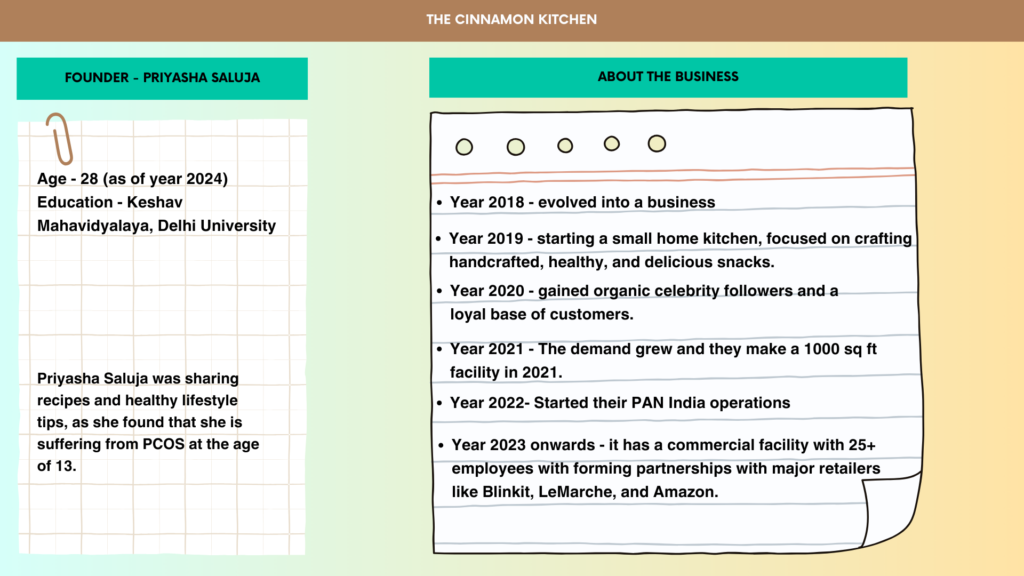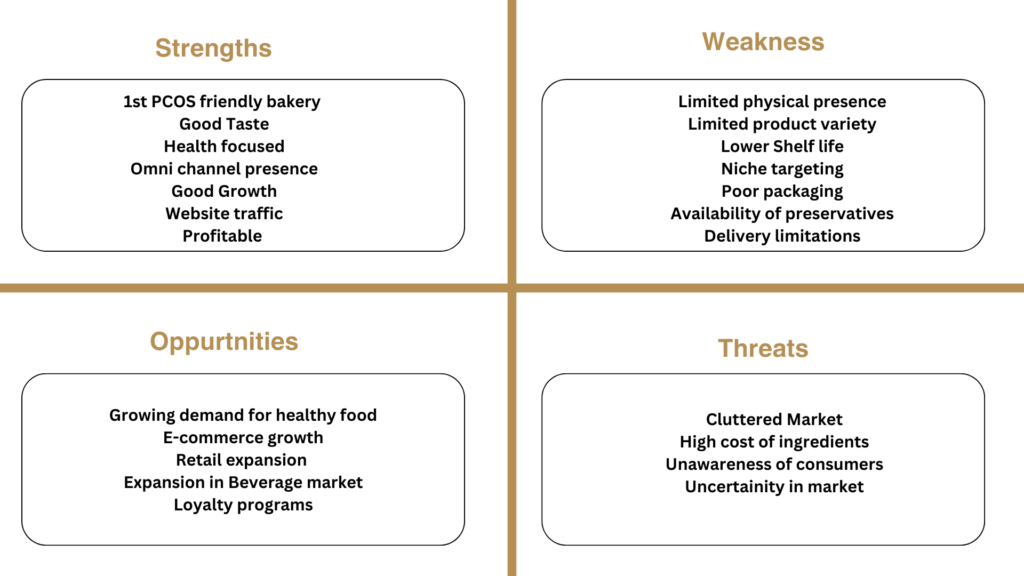Table of Contents
The Cinnamon Kitchen - Introduction

Internal Analysis

Requirement 1 – To understand any business is what are their offerings
There are 4 pillars for any product-based business and in marketing these are known as the Marketing mix
1st P of marketing mix is Product and Product refers to the item that is offered to sell.
The Cinnamon Kitchen has a wide variety of 45 SKUs catering to different dietary needs and preferences (e.g., Keto, vegan, etc.) and all of them falls under these categories:-
- Freshly baked goods: Cakes, available only in Delhi NCR.
- Packaged snacks: Cookies, chips, and other shelf-stable treats. These are gluten-free, refined sugar-free, and plant-based. Keto cakes, vegan cheese chips, and lemon lavender cookies.
2nd P of Marketing Mix is Price, and Price is what the customer pays to own or use that product. Now their are many ways in which a company can select their pricing strategy. Now in case of The Cinnamon Kitchen, we believe they have used a mix of below mentioned pricing strategies:-
- Premium Pricing: Several products have relatively high prices compared to similar items in the Indian market (e.g., Keto Nutella at ₹650, Travel Cakes at ₹1200-1600). This suggests an element of premium pricing based on high-quality ingredients and healthy positioning.
- Cost-Plus Pricing: Some lower-priced items like Chocolate Peanut Butter (₹350) might indicate a cost-plus pricing approach, where a markup is added to production costs.
- Value-Based Pricing: The focus on health benefits and unique ingredients points towards a possible value-based pricing element, where prices reflect perceived value beyond just cost.
3d P of Marketing Mix is Place and Place refers to where the product is available. In case of The Cinnamon Kitchen:-
- Primary sales channel through own website, Amazon, Blinkit
- Limited presence in a few select retail stores, Own retail stores.
Note: Based on our research, The Cinnamon Kitchen will expand its distribution channels in the future, potentially including more retail partnerships.
4th P of the marketing mix is Promotion and Promotion refers to techniques and strategies by which the target audience can know about that product.
- Packaging QR code: Drives initial product engagement, promotes brand discovery, and facilitates data collection.
- Omnichannel marketing: Utilizes social media and content marketing across online and offline channels.
- Performance marketing: The reason behind the significant growth of the Cinnamon Kitchen was Performance Marketing.
Requirement 2 – To Analyse the Business is Choosing the Ideal Customer and How the Brand will Differentiate from the Competition
Segmentation is a way of creating different groups of customers, and companies can use segmentation to decide which strategy will work for which group of customers.
- Demographics: The startup is segmenting on the basis of income
- Psychographics: The segmentation is also done based on their values, life goals, beliefs and awareness.
- Behavioural: Further segmentation is based on customers buying behaviour, spending habits, and lifestyle.
Based on the segmentation, the brand Target Audience is :-
- Premium customers – As mentioned by the sharks the prices of brand’s products is very high and targeting high income level customers who pays high for quality and materials used.
- Health-conscious food lovers and cruelty free: The brand is targeting people who wants to remain healthy but also want to eat tasty food with being totally vegan free.
- People with dietary restrictions: The brand is targeting segment who is looking for gluten-free, vegan, and other allergy-friendly options, online shoppers, frequent snackers and who are willing to pay a premium for healthy and high-quality products including gifting purposes.
The Cinnamon Kitchen’s positioning is Product Attributes, Product Class and Product User.
Its appeal to a niche audience, who appreciate top-notch quality, health-conscious consumers seeking ethical options, and individuals with specific dietary needs. It assembles a community of like-minded individuals who value both superior taste and conscious living.
External Analysis

Market Potential:
The Indian snacking market is massive, valued at approximately ₹70,000 crores.
The health-focused segment within this market holds significant potential, currently valued at ₹10,500 crores (15% of full industry) and boasting a 20% CAGR, double the industry average of 10%.
This growth is further fueled by a rising health consciousness with the number of health-conscious consumers projected to reach 176 million by 2026.
As per Avendus Capital report highlights:
Increasing health-conscious consumers: 108 million in 2020 to 176 million in 2026.
Shifting snacking habits:
- 64% replace meals with healthy snacks.
- 47% consume snacks 2-3 times a day.
- 27% even snack at night.
Informed purchase decisions: 85% consider brand, packaging, and nutritional value.
But this heath-based segment market has grown some sight of hope after the pandemic when people started focusing on health-based products which is new for the investors and even till no startup was able to grow at that much level
Hence The market is progressing at a commendable pace, demonstrating promising growth, especially with the pandemic acting as a catalyst for increased focus on health-based products. However, the novelty of this health-focused segment introduces an element of risk, given the absence of established examples in the market. Despite the potential challenges, the trajectory suggests a favorable landscape for innovative ventures in the evolving snacking industry.
SWOT Analysis

Now, after finding and understanding both the internal and external environment of a business, we do the SWOT analysis. SWOT analysis provides a clear idea about the business.
Conclusion
Key learnings from this pitch and business includes:-
- First Impressions Matter: The sharks emphasized the significance of a well-executed presentation, underscoring the importance of how you portray yourself and your business to crack the deal successfully.
- Fundraising Challenges: The pitcher’s lack of experience in structuring compelling deals, leading to uncertainties and potential deal cancellation by Sharks Anupam and Vinita.
- Equity vs. Debt: Drawing from Zomato’s founder, the sharks highlighted the principle that equity, with its increased stake and interest, is deemed more valuable than debt in business partnerships.
- Promoter’s Stake and Liquidation Advantage: The founder of Zomato, acting as a shark, pointed out the strategic advantage for new businesses when promoters hold a substantial share, offering potential liquidation for enhanced funding and growth.
- Resilience Amidst Constraints: The pitcher’s unwavering determination was showcased when, faced with financial limitations, she personally took the initiative to cut costs, exemplified by trimming down logo expenses.
- Effective Communication Triumphs: Despite differing viewpoints, the pitcher’s success lay in her adept communication style – a balance of gentleness, respect, and a strong commitment to her plan, leaving a lasting impression.
- Packaging Matters in Business: The sharks highlighted the importance of business packaging, emphasizing factors such as high-quality presentation, readability, and cohesive color themes for a successful business pitch.
- Good branding – The pitcher was focused on creating a brand rather than just selling a product as appreciated by Shark Vinita and her emphasis on creating a brand story and website traffic.
So this is our pitch analysis of one of the most popular pitches of shark tank which shows us the impact that a good presentation, good communication skills and a growing business make. The Cinnamon Kitchen is a delicious blend of health consciousness, luxury offerings and a strong brand statement, reflecting the broad development possibilities of the Shades in Business. We addressed not only the challenges of the business case but the landscape of today’s business.

